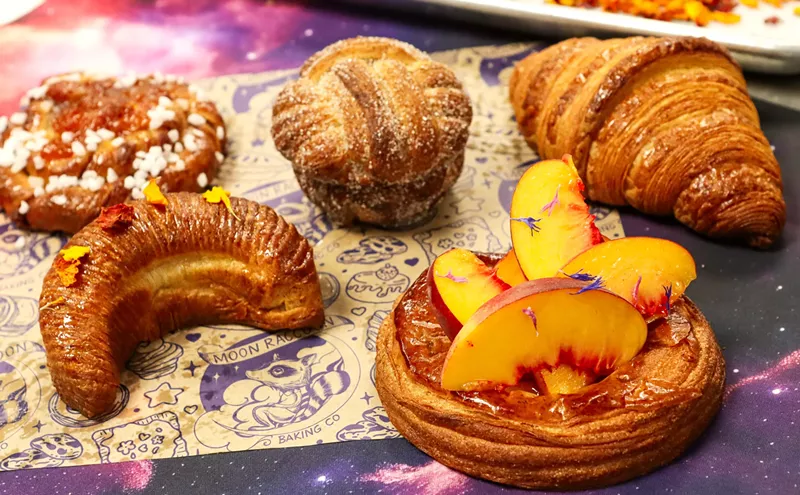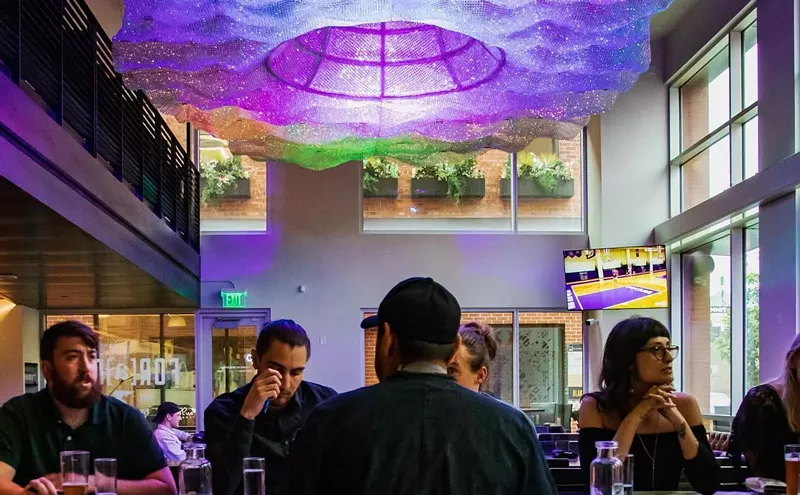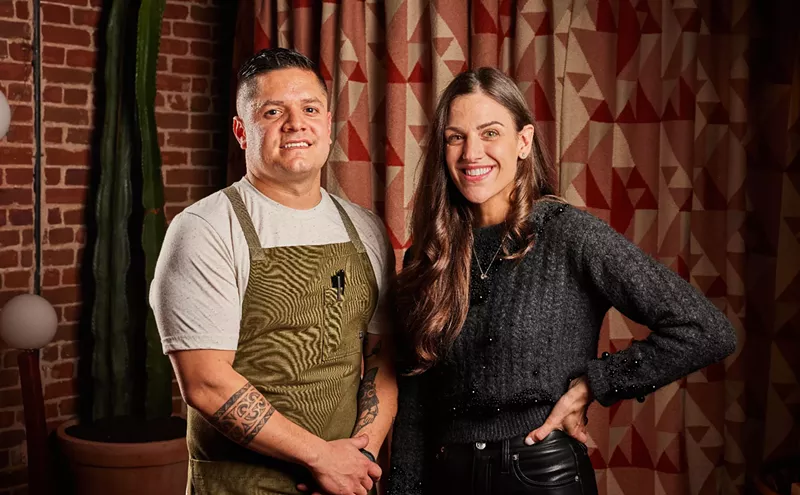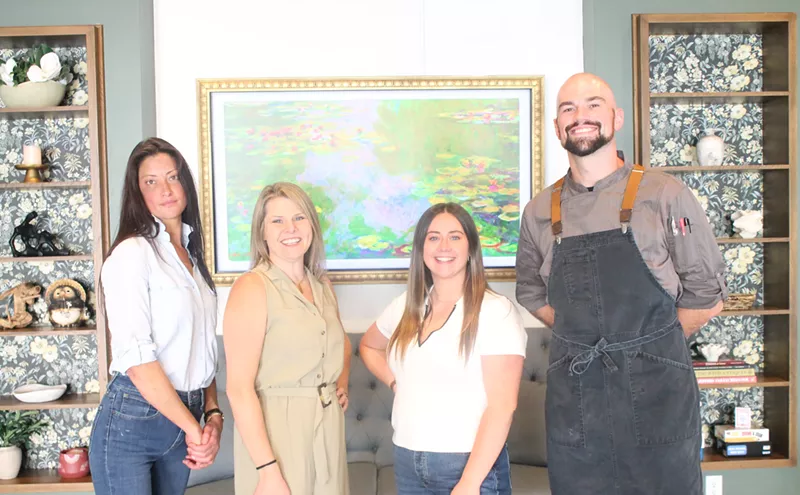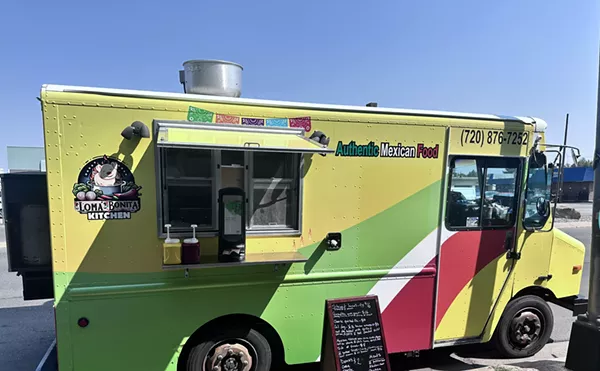Mel Master, current owner of three restaurants in metro Denver, former owner of a half-dozen more in Denver and Manhattan, wine guy, ex-street musician, enthusiastic raconteur of all things boozy and delicious, and the guy I blame for loosing Bobby Flay on the world, is not in the house tonight. Jane, his wife and partner — beautiful, mouthy and British, a trained chef with a better resumé than most of her employees who made her bones back in the big-hat boys'-club days, wonderfully inappropriate company in just about any situation — is also not in attendance.
Laura and I have made sure. We've skulked like a couple of dopey second-story men by the brick-walled trench that separates the front door of Agave Grill from the massive parking lot, me smoking, she pacing, both of us peeking through the windows and scanning the floor, casing the joint for the Masters, listening for the tell-tale booms and peals of their combined laughter. I called before leaving the house, asked for Mel, for Jane, and was told by a hostess that neither were around and that she wasn't exactly sure where they were. The two of them travel a lot — Paris, London, California, Mexico, islands I've never heard of, where I like to imagine they have a secret fortress and second lives as evil, international supervillains or retired MI6 field operatives.
But still, they live relatively close to this strip mall, and their offices are just a couple of doors down, between Agave Grill and the Greenwood Village incarnation of Mel's, the restaurant they opened in Cherry Creek a dozen years ago and closed last year. Their son, Charlie, runs the floor at this Mel's, and all three of them are always running back and forth between their restaurants. We want to steer clear of the entire Master family for this final meal.
I crush out my smoke in the nearest ashtray and look over at Laura. For years, I've been suggesting that we work out a complicated series of secret hand signals so that we can communicate in silence like the guys in war movies do. For years, Laura has insisted that this is stupid and refuses to play along. So rather than doing the whole point-to-my-eyes, tug-on-my-ear, gesture-left-flank dance right there in the parking lot, I just walk over to her and ask, "So, uh, do you see 'em anywhere?"
"No."
"See Charlie at the bar?"
"No. Can we go eat now, James Bond?"
For the record, she did not mean that as a compliment.
This space was once home to Ocotillo, a Southwestern restaurant that never really quite caught fire. When it closed last year, the Masters picked it up, along with the former home of its sister restaurant, Ventura Grill. That became the California-inspired Montecito South, echoing the couple's new place on Sixth Avenue. And after a lightning turnaround — slapping on some paint, adding a few touches of continental decor and dumping the Southwestern theme in favor of an upscale steakhouse and bistro look — Ocotillo became Annabel's, named after Charlie's daughter. Executive chef Adam Mali oversaw the food at all three restaurants, while Chad Clevenger, the chef who'd presided over the closing of the original Mel's, went off to France to work as a private chef for some friends of Mel and Jane's.
But as it turned out, the Mel's era was not yet over. Within a few months, the Masters had turned both Montecitos into new versions of Mel's, Mali left for California, and Clevenger was called back, trading his c-de-c title for the big hat and black pants of the exec in charge of both the Mel's outposts and Annabel's. This worked for about five minutes — roughly the amount of time it took Mel and Jane to realize that with two now-similar restaurants set side by side, they were poaching their own customers, so they decided to turn Annabel's into the Mexican/New Mexican, nouveau-Southwestern Agave Grill.
It's a style that plays to Clevenger's strengths. Before coming to Denver and getting folded into the embrace of the Master clan, he'd cooked under Mark Miller at the deservedly famous Coyote Cafe in Santa Fe, so he came with the chops to steam a tamale and roast a chile. And he injected a nice dose of Southwestern flavor into the menu at the original Mel's, which had been solidly Euro-centric for over a decade. At Agave, Clevenger would have the freedom to experiment with deconstructionism, French technique, Old World flavors and a certain sense of arte moderne New World design. And he'd have help from Edgar Martinez, the chef de cuisine. While the Masters presided over Mel's, Agave would be Clevenger's place — a showcase for his particular skill set, for the unique intersection of his style.
But as you step into Agave, there's an undeniable sense of dislocation. It's a good-looking restaurant, but it feels like a European restaurant — the yellow stucco walls and exposed brickwork and smooth hardwood floor very faux-French bistro, the white tablecloths and stemware upping the ante to formidable levels of class. The swooping bar and servers in black-and-white house livery delivering Clevenger's chile rellenos and Mexican white-shrimp ceviche seem like temporary lodgers in someone else's house. And while I'm not about to insist that every Mexican restaurant dress its servers in sombreros, it will take more than a couple of woven rungs nailed to the wall to cure this disjointedness.
Good thing, then, that on our first visit, Laura and I were shown to a table on the patio that — with its large, held-over-from-Ocotillo fire pit, commanding view of the Greenwood Village greenery and ashtrays if you know who to ask — is one of the great patios of the suburbs. Here, all my qualms about the room and floor staff (most of whom were young, exceedingly chipper and plastered with gee-whiz-ain't-it-great-to-be-out-at-a-restaurant smiles) were swept away on a wave of chips and excellent salsa (the tomatillo is the best), cold beers, sweet-potato flautas and tortilla soup. Clearly, Clevenger had managed to reconcile, both within himself and on his board, those competing urges toward Southwestern traditionalism, American modernism and Old World classicism far better than the actual, physical space of Agave had. While I could plainly see the bones of past failures poking through the thin skin of slapdash re-concepting, the menu was entirely self-possessed and presented with solid, unwavering confidence.
Which, of course, should've immediately triggered in me the worry that it was going to change again, and soon.
Which, of course, it did.
About three weeks ago, Clevenger and Martinez put Agave through a mid-season menu overhaul, altering or outright dumping about two-thirds of the opening board. While the result could have been a return to the mixed Chihuahua-meets-Lyon Old World/New World fusion of the Cherry Creek Mel's during Clevenger's days there, he surprised me again by further refining the kitchen's output so that his new menu, far from aping the doomed nouvelle Mexican trends of five years ago, went even thinner on the classical conceits until they became a near-invisible presence that existed only in the hands of Clevenger and his cooks.
The cauliflower-and-jalapeño soup, for example, was a perfectly traditional cream soup, built up in the French style from its constituent parts, touched with a lace of smoked paprika oil (hardly a standard ingredient in any abuela's kitchen — not that cauliflower is one, either) and topped with shrimp painted in tamarind juice and roughly grilled. At first blush, it was beautiful, restrained, smart and completely appropriate to the menu — even if by third or fourth blush it seemed more Indian (dot-on-the-head Indian, not hey-welcome-to-our-casino Indian) than Southwestern. A beet salad with goat cheese, fennel and arugula is more or less the definition of California cuisine; I'm pretty sure the Bolinas revolutionaries have a picture of a beet-and-goat-cheese salad on their flag. Yet the sweet corn that crusted the goat cheese and a tangerine-chile vinaigrette planted this firmly on the Agave lineup, with a decidedly Southwestern bass note and high note that colored all the California in between.
On this visit, I was well served in a room where I was the youngest customer by twenty years, easy. Still, the moneyed and aged neighbors who filled the place seemed to be enjoying their smooshed-to-order guacamole and cheese flautas (which had replaced the sweet-potato flautas) fancied up with a mushroom salsa, charred scallions and black truffles that smelled like the sweat of the earth. Who but a classically influenced chef is going to add deliberately charred greens to a dish? In your run-of-the-mill Southwestern restaurant, charred scallions would just be burnt onions and cause for mutiny. And who but a fella just back from the City of Light would do a green-chile béarnaise on a steak, or use Swiss chard, a strawberry glaze and celeriac purée spiked with mezcal on a nice, fat pork chop?
For our final Masters-free meal at Agave, Laura and I are seated in the back of the main room, where the bistro-not-cantina vibe is strongest. We devour chile-marinated rock shrimp wrapped up inside mini black-bean gorditas, an absolutely gorgeous and unbelievably delicious pork tamale (the pig braised in achiote before being wrapped in light, sweet masa dough) and deconstructed beef tacos made with cubed, marinated Kobe on a plate of jicama slaw, tortillas and a half-dozen sauces. Then comes Clevenger's low-country-meets-Tex-Mex version of chicken and waffles: perfectly golden-brown, seared free-range chicken breasts, the skin crisp, the meat impossibly juicy, reclining against a quartered pecan waffle made with a rice batter and spiked with herbs, the whole thing sitting in a tequila-maple "sauce" that isn't even close to syrup (and probably isn't supposed to be) and tastes burnt. A plate of chicken and waffles needs the sweetness of syrup to make it work; this doesn't have it.
Then, as we get ready to leave, we spot Clevenger and try to look inconspicuous. His food has already told us everything we need to know, and anyway, he has work to do: performing his French prep with his Southwestern ingredients, melding New American with the flavors of the Old World. Clevenger is an explorer, an adventurer. He is a guy uniquely qualified to cut this trail and lead his customers into a whole New World of flavor than what has come before.



